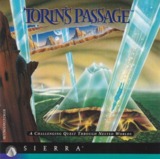The interface is typical of late Sierra adventure games, and is essentially that of King's Quest VII: The Princeless Bride. Played from a third-person perspective, the gamer controls Torin's actions using a "smart" pointer. When rolled over a hot spot in Torin's environment, it glows white, allowing for interaction. No glow, no go. While this is a useful innovation for novice adventure gamers, it suffers from the same over-simplicity that hurt King's Quest VII. In the first world, the Lands Above, there are many hotspots—some provoking humorous comments from our protagonist, others used to solve problems or collect as inventory. However, by the third world, these hotspots quickly dry up, so that every opportunity for interaction becomes essential to your quest. This had the unfortunate effect of narrowing the range and variety of puzzles, and meant that several worlds were hollow and failed to capture my interest. The interface also contains a scanning platform for inventory objects, allowing the gamer to view inventory in 3D and rotate it. Although initially appealing, this element is criminally underused, with few real applications in the game. Comments from Torin on his inventory, instead of the ability to rotate it would have been more use—and more entertaining. The gamer is also offered the option of a "Script" feature that records the dialogue to be reviewed at leisure. Again, I barely used this feature of the interface, and perhaps the effort put into developing it could have been better spent elsewhere.
The backdrops to the game are beautifully detailed and generally a pleasure to encounter, with each world having its own distinct visual flavour, from the greenery of the third world, Pergola, to the desolate, lava filled landscapes of Asthenia. Regrettably, these realistic backgrounds are overlaid with Disney style characters and cartoon type animations, ill suited to such an environment. Although both components were strong individually, they seemed to be in discord when combined. On a positive note, the animations themselves are quite charming to watch, with Torin leaping and bounding with exhausting athleticism from one world to the next.
The music is generally well-suited, with each world having its own distinct themes. It is neither intrusive nor remarkable, except for the signature theme, which adds to the ambient feel of the cut scenes. The voice acting attained a similar level of "high-mediocre" though I am unsure of just how many times I could tolerate Boogle's incessant "Mugommphalon."
With regard to technical issues, running Torin's Passage in Windows 98 did cause a number of problems. The display had to be adjusted to 256 colours—not an unusual practice for older adventure games, but one causing problems under my system configurations. Most significantly the game had the tendency to crash on several occasions during cut scenes, causing total system lock-ups. Occurring at key dramatic moments, it was particularly irritating, and while not making the game intolerable to play, it detracted from the experience and severed any sense of immersion.
In conclusion, this game is one best left to the kids, or else a means for older adventurers to procrastinate whilst waiting for the next classic to materialize. It would be unfair to say I hated this game, and indeed it had many positive qualities, but lacking in imagination and humour it became bland and unoriginal. Despite a promising start, Torin's Passage never breaks through a barrier of mediocrity.

